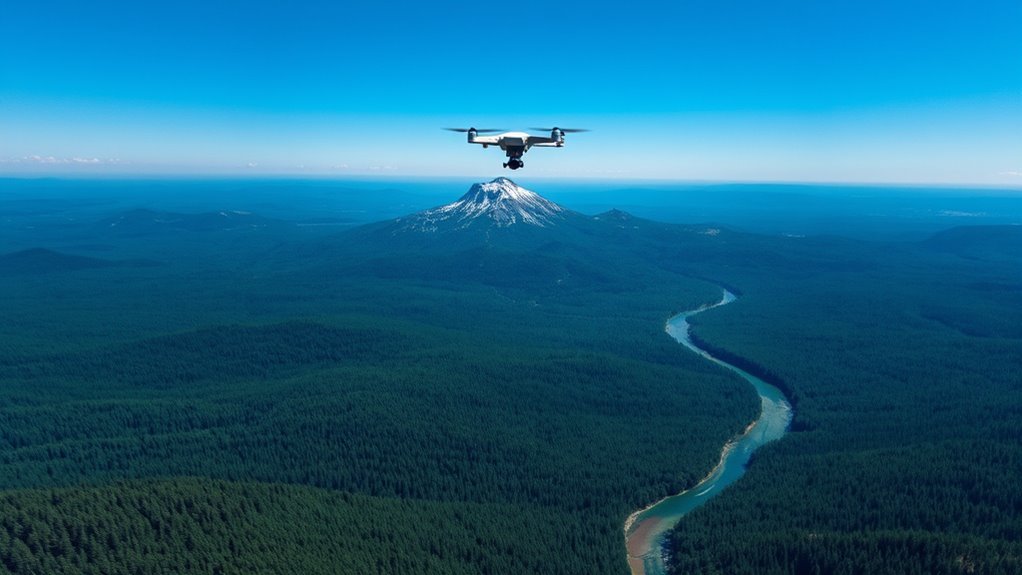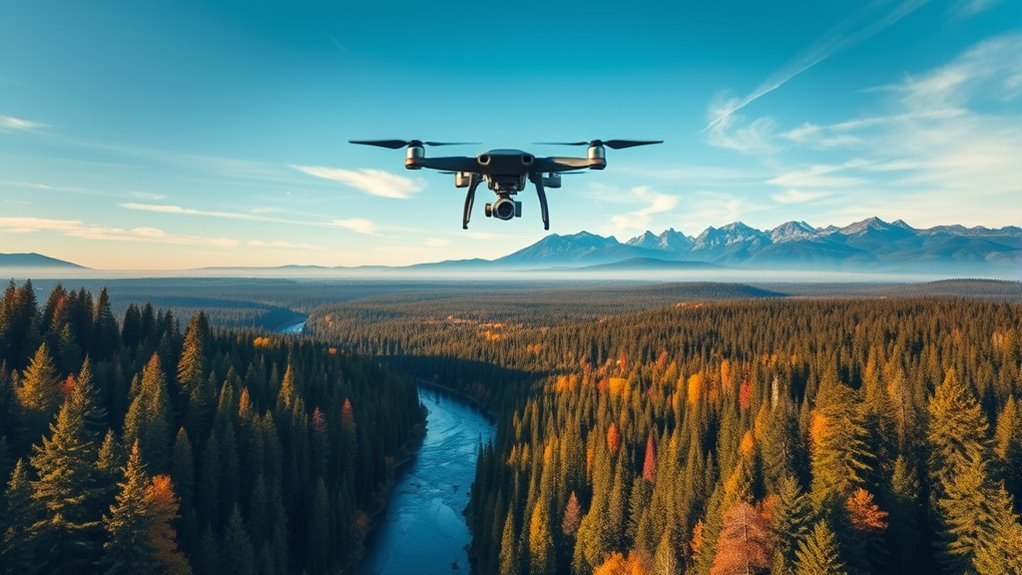Drones are generally restricted in national forests to protect wildlife and ecosystems, and you’ll need to understand specific regulations for each area. Compliance with Federal Aviation Administration (FAA) guidelines is also essential, including altitude limits and no-fly zones. In many cases, you’ll require a permit to operate drones in these locations. Operating responsibly minimizes environmental impact and potential penalties. For further insights into regulations and best practices, additional information is available.
Understanding National Forest Regulations

Although the allure of flying drones in national forests can be tempting, understanding the regulations that govern their use is essential for both compliance and conservation. Drones can considerably impact wildlife and delicate ecosystems, making it crucial to examine their environmental implications. Regulations are designed to protect forest conservation efforts, ensuring that natural habitats remain undisturbed. You’ll need to familiarize yourself with specific guidelines that vary by region, including restrictions on flight altitude and areas designated as sensitive. Ignoring these rules can lead to fines and hinder conservation initiatives. By respecting the established regulations, you not only safeguard the environment but also contribute to a collective effort in preserving these natural resources for future generations.
Federal Aviation Administration (FAA) Guidelines

When operating drones in national forests, it’s crucial to understand the FAA guidelines that govern their use. These regulations outline specific requirements and restrictions, particularly in designated areas where drone activity may be limited or prohibited. By familiarizing yourself with these rules, you can guarantee compliance and promote safety in these natural spaces.
Drone Regulations Overview
Drones have become increasingly popular in various sectors, leading to the establishment of specific regulations by the Federal Aviation Administration (FAA) to guarantee safety and compliance. These guidelines focus on drone safety while allowing enthusiasts like you to explore aerial photography. When operating a drone, you must adhere to certain restrictions, such as maintaining visual line of sight and flying below 400 feet. Additionally, you can’t fly over people or near airports without proper authorization. It’s essential to register your drone if it weighs over 0.55 pounds. By understanding and following these regulations, you can enjoy your aerial pursuits while minimizing risks and ensuring a responsible approach to drone use in national forests and beyond.
Restricted Areas Explained
Understanding the restrictions imposed on drone operations in national forests is essential for ensuring compliance with FAA guidelines. Drones are prohibited in designated restricted areas, which often include zones around airports and sensitive wildlife habitats. This is critical for maintaining drone safety and protecting natural resources. Violating these restrictions can lead to fines and jeopardize forest conservation efforts.
When planning your flight, it’s important to consult the FAA’s airspace maps to identify any no-fly zones. Respecting these limitations not only safeguards your freedom to fly but also supports the preservation of the environment. By adhering to these guidelines, you contribute to both personal responsibility and the larger goal of sustainable forest management.
Drone Usage Restrictions in Wilderness Areas

When considering drone usage in wilderness areas, it’s vital to understand the specific regulations that govern these pristine environments. Flight restrictions often arise from the need to protect wildlife and maintain the natural landscape, requiring you to navigate a complex permitting process. Understanding these rules is important for ensuring compliance and respectful engagement with these protected spaces.
Wilderness Area Regulations
While the allure of capturing breathtaking aerial views might tempt many, regulations governing drone usage in wilderness areas are strict and non-negotiable. These areas are designated primarily for wilderness conservation, meaning they’re intended to preserve the natural environment without human interference. Drones pose significant environmental impact risks, including noise pollution and disturbances to wildlife. The National Wilderness Preservation System, aimed at maintaining these pristine landscapes, prohibits drone usage to guarantee minimal human footprint. Violating these regulations not only disrupts the delicate balance of ecosystems but also undermines the freedom to enjoy nature in its untouched form. If you’re considering drone usage in these areas, it’s essential to respect these rules to protect the wilderness for future generations.
Flight Restrictions Explained
Although the appeal of drone photography in national forests is undeniable, understanding the flight restrictions in these areas is crucial for compliance and conservation. Many national forests have designated wilderness areas where drone technology is strictly prohibited. This restriction aims to minimize the environmental impact on delicate ecosystems and wildlife habitats. Flying drones in these regions can disturb animals and disrupt their natural behaviors, leading to long-term ecological consequences. Additionally, certain altitude limits and no-fly zones may apply in various forested areas to guarantee safety and protect natural landscapes. By respecting these regulations, you contribute to preserving the beauty and integrity of national forests, allowing future generations to enjoy their wonders. Always check the specific guidelines for the area you plan to explore.
Permitting and Permissions
Understanding the permitting and permissions required for drone usage in wilderness areas is essential for responsible aerial exploration. Many national forests have specific regulations to protect wildlife and their habitats. You’ll need to familiarize yourself with local laws, as failure to comply can lead to significant fines or restrictions. Practicing proper drone etiquette, such as avoiding sensitive areas and minimizing noise, not only enhances your experience but also reduces your environmental impact. Always check for required permits and adhere to designated flight paths. By respecting these guidelines, you can enjoy the freedom of drone flight while contributing to the preservation of our natural landscapes. Stay informed and act responsibly to guarantee future generations can also enjoy these pristine wilderness areas.
Permits Required for Drone Operation
Before you take to the skies with a drone in national forests, it’s essential to be aware that permits are often required. Understanding the application process can help guarantee you’re compliant and can enjoy your flight without interruption. Here are three key points to reflect upon:
- Check the Specific Forest Regulations: Each national forest may have differing rules regarding drone permits.
- Submit a Drone Permit Application: This may involve providing details about your intended use and the area you plan to fly in.
- Allow Time for Approval: Permit processing can take time, so apply well in advance of your planned flight.
Wildlife Protection and Drone Use
Following the necessary permit acquisition, it’s vital to evaluate the impact of drone use on wildlife within national forests. The use of drones can lead to significant wildlife disturbance, particularly during sensitive periods such as breeding or nesting seasons. Research indicates that the presence of drones may cause animals to alter their behavior, leading to stress and potential abandonment of habitats. Understanding the drone impact on wildlife is imperative for responsible use; ensuring that your activities don’t inadvertently harm the ecosystems you wish to explore. By prioritizing wildlife protection, you can enjoy the freedom of drone operation while safeguarding the delicate balance of these natural environments. Ultimately, informed drone use can coexist with wildlife conservation efforts in national forests.
Safety Considerations for Drone Pilots
As drone technology continues to evolve, guaranteeing the safety of both pilots and the environment becomes increasingly important. To maintain pilot safety and promote wildlife awareness, consider the following:
- Stay Informed: Regularly check local regulations regarding drone use in national forests to avoid fines or legal issues.
- Respect Wildlife: Keep a safe distance from animals, especially during breeding seasons, to minimize stress or disruption.
- Maintain Line of Sight: Always keep your drone in view to prevent collisions and guarantee you can react promptly to unexpected obstacles.
Best Practices for Aerial Photography
Capturing stunning aerial photographs in national forests requires a blend of technical skill and environmental sensitivity. To achieve this, you should familiarize yourself with essential aerial techniques that enhance image quality while respecting wildlife and natural habitats. Invest in high-quality photography equipment, such as drones with advanced cameras and stabilization features, to guarantee clarity and detail in your shots. Before flying, plan your route carefully to avoid sensitive areas and minimize disturbances, especially considering state and local laws that may affect your flight. Utilize proper settings like aperture and shutter speed to adapt to varying lighting conditions. Additionally, consider the time of day; golden hours often yield the most enchanting light. By adhering to these best practices, you can create breathtaking imagery while preserving the integrity of the national forests you cherish. Moreover, choosing drones with advanced camera capabilities can significantly improve your photography results in challenging conditions.
Consequences of Violating Drone Regulations
While the allure of flying drones in national forests can be tempting, violating established regulations can lead to significant consequences. If you disregard these rules, you might face serious repercussions, including:
- Penalties Enforcement: Fines can range from hundreds to thousands of dollars, depending on the severity of the violation.
- Legal Consequences: Engaging in unauthorized drone activities can result in criminal charges, impacting your record and future drone usage.
- Loss of Privileges: Repeat offenders risk having their drone flying privileges revoked, limiting your ability to enjoy aerial perspectives in public lands.
Understanding these potential outcomes is vital for anyone considering drone operation in national forests. It’s important to respect regulations to avoid unnecessary complications and guarantee your freedom to explore remains intact.
Resources for Responsible Drone Flying
To guarantee safe and responsible drone flying in national forests, it is vital to access the right resources that provide guidance on regulations, best practices, and environmental considerations. Familiarize yourself with the Federal Aviation Administration (FAA) guidelines, which outline drone safety protocols and legal requirements. Additionally, consult the U.S. Forest Service for specific rules regarding drone use in national parks and forests. Local drone clubs and online forums can offer valuable insights and experiences from fellow enthusiasts, promoting responsible flying. Always remain aware of wildlife and natural habitats, as protecting the environment is significant. By utilizing these resources, you can enjoy the freedom of flying while ensuring compliance with regulations and minimizing your impact on the natural world. Furthermore, be mindful of local laws that could affect your drone operations, as they ensure a safe and responsible drone experience.
Frequently Asked Questions
Can I Fly My Drone During Hunting Season in National Forests?
While it might seem thrilling to soar your drone during hunting season, you must heed drone regulations. Prioritize hunting safety and check local guidelines, as flying could inadvertently jeopardize wildlife and disrupt hunters in the field.
Are There Specific Areas Within Forests Where Drones Are Completely Banned?
Yes, certain areas may have strict drone regulations due to forest management policies. These restrictions often protect wildlife, minimize disturbances, or preserve natural resources, so it’s essential to check local regulations before flying your drone.
What Happens if My Drone Crashes in a National Forest?
If your drone crashes in a national forest, you’ll need to focus on recovery. However, you could face legal consequences depending on the circumstances, such as violating regulations or disturbing wildlife during the retrieval process.
Can I Use My Drone for Commercial Purposes in National Forests?
Over 100,000 commercial drone licenses have been issued in the U.S. However, you’ll need to adhere to drone regulations specific to national forests. Always guarantee you’ve got the necessary permits before flying for commercial purposes.
Are There Any Age Restrictions for Flying Drones in National Forests?
When considering drone regulations, you’ll find there are no specific age requirements mandated for flying drones in national forests. However, it’s wise to check local laws and make certain you’re responsible and informed about safe operation.

